Tatarstan |
|
|
|
| Übersicht – Contents: | |
Diese Seite ist Teil des Projektes
Tatarstan |
|
|
|
| Übersicht – Contents: | |
Flagge – Flag: |
|
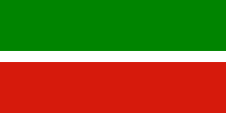 |
Nationalflagge – national flag, Seitenverhältnis – ratio = 1:2, Quelle/Source, nach/by: Flaggen Enzyklopädie |
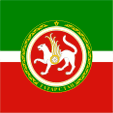 |
Flagge des Präsidenten – flag of the President, Seitenverhältnis – ratio = 1:1, Quelle/Source, nach/by: Flags of the World |
historische Flaggen – historical Flags: |
|
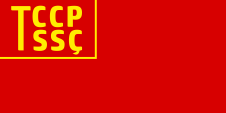 |
1920–1937, Flagge der Autonomen Sowjetrepublik – flag of the autonomous soviet republic, Seitenverhältnis – ratio = 1:2, Quelle/Source, nach/by: World Statesmen |
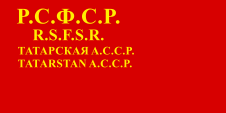 |
1937–1938, Flagge der Autonomen Sowjetrepublik – flag of the autonomous soviet republic, Seitenverhältnis – ratio = 1:2, Quelle/Source, nach/by: World Statesmen |
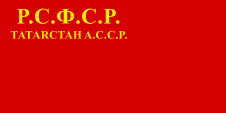 |
1938–1954, Flagge der Autonomen Sowjetrepublik – flag of the autonomous soviet republic, Seitenverhältnis – ratio = 1:2, Quelle/Source, nach/by: World Statesmen |
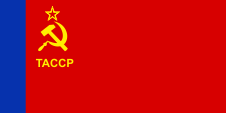 |
1954–1978, Flagge der Autonomen Sowjetrepublik – flag of the autonomous soviet republic, Seitenverhältnis – ratio = 1:2, Quelle/Source, nach/by: World Statesmen |
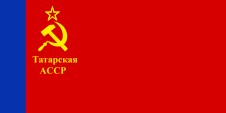 |
1978–1991, Flagge der Autonomen Sowjetrepublik – flag of the autonomous soviet republic, Seitenverhältnis – ratio = 1:2, Quelle/Source, nach/by: World Statesmen |
|
siehe auch – look also: Flaggengeschichte der Sowjetrepubliken der UdSSR – flag history of the soviet republics of the USSR |
|
|
|
|
Bedeutung/Ursprung der Flagge – Meaning/Origin of the Flag: |
|
| Die Flagge von Tatarstan wurde am 29.11.1991 eingeführt. Sie zeigt drei horizontale Streifen in Grün, Weiß und Rot, wobei der weiße Streifen nur ein sehr schmaler Trennstreifen ist. Grün steht für die Tataren und ist die Farbe des Islam, Rot steht für die Russen. Der weiße Streifen symbolisiert den Frieden zwischen diesen beiden Bevölkerungsgruppen. | The flag of Tatarstan was introduced on 29th of November in 1991. It shows three horizontal stripes in green, white and red, but the white stripe is only a very slender separating stripe. Green stands for the Tatars and is the colour of the Islam, red stands for the Russians. The white stripe symbolizes the peace between this population groups. |
| Die Flaggen, die zu Sowjet-Zeiten verwendet wurden, entsprachen alle dem immer gleichen Schema, wie es für Sowjetische Autonome Republiken vorgesehen war: Zwischen 1923 und 1937 oft nur ein einfabiges rotes Flaggentuch mit einer goldenen Inschrift, die den Landesnamen zeigte. Manchmal nur als Abkürzung, manchmal mit vollem Namen, manchmal nur in Russisch oder auch mehrsprachig. Ab etwa 1937 wurden manchmal noch Hammer, Sichel und Stern ergänzt. Ab etwa der Mitte der 50-er Jahre wurden mehrfarbige Flaggen für die Republiken der Sowjetunion eingeführt, deren Strickmuster die untergeordneten Autonomen Sowjetrepubliken zu übernehmen hatten. |
The flags, which were used in the Soviet era corresponded all to the same
pattern as it was intended for the Soviet Autonomous Republics:
Between 1923 and 1937 frequently only a single-coloured red bunting with a golden inscription, showing the name of the country. Sometimes only as a shortcut, sometimes the full name, sometimes only in Russian or even multilingual. From about 1937 hammer, sickle and star were sometimes added. From about the mid-50s multicolored flags were introduced for the republics of the Soviet Union, whose knitting patterns had to be taken over by the subordinated autonomous Soviet republics. |
| Quelle/Source nach/by: Volker Preuß, Flaggen Enzyklopädie | |
Wappen – Coat of Arms: |
|
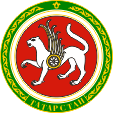 |
Wappen der Republik Tatarstan – coat of arms of the Republic of Tatarstan, Quelle/Source: Russiatrek |
Bedeutung/Ursprung des Wappens – Meaning/Origin of the Coat of Arms: |
|
| Den Mittelpunkt des Wappens bildet eine Tierdarstellung. Es ist ein Schneeleopard, "Ak Bars" genannt. Er geht auf das Reich der Wolgabulgaren und das Khanat Kasan zurück, beides Vorgängerstaaten des heutigen Tatarstans. | The heart
of the coat of arms is an animal representation. It is a snow leopard, called
"Ak Bars". It dates back to the Wolgabulgars Empire and the Khanate of Kazan,
both previous states of today's Tatarstan. |
| Quelle/Source nach/by: Volker Preuß, Wikipedia (EN) | |
Landkarten – Maps: |
geographische Lage in Russland – geographical position within Russia: |
Landkarte des Landes – map of the country: |
Zahlen und Fakten – Numbers and Facts: |
|
|
|
|
|
|
|
|
|
|
|
|
|
|
|
|
|
|
|
|
Geschichte: |
|
10. Jahrhundert · Reich der Wolgabulgaren 1236 · Mongoleneinfall, Errichtung des Khanats Kasan, später Islamisierung 1552 · Eroberung durch Russland unter Zar Iwan IV. (Iwan der Schreckliche), später Bildung des Gouvernements Kasan 1917 · Errichtung der Sowjetmacht 27.05.1920 · Gründung der Tatarischen Autonomen Sozialistischen Sowjetrepublik 1927 · Einführung der lateinischen Schrift 1936 · Einführung der kyrillischen Schrift 30.08.1990 · Tatarstan erklärt seine Souveränität 31.12.1991 · die Sowjetunion löst sich auf, die Verfassung der Russischen Sozialistischen Föderativen Sowjetrepublik (RSFSR, Russland), ein ehemaliger Teilstaat der Sowjetunion bleibt vorerst in Kraft 25.12.1993 · eine neue Verfassung für Russland (Russische Föderation) tritt in Kraft, das Verhältnis zu den Gliedern der Föderation wird damit neu geregelt |
History: |
|
10th century · Empire of the Volga Bulgars 1236 · Mongol invasion, establishment of the Khanate of Kasan, later islamization 1552 · conquest by Russia under Tsar Ivan IV. (Ivan the Terrible), later formation of the Gouvernement of Kasan 1917 · establishment of the Soviet power 27th of May 1920 · formation of the Tatarian Autonomous Socialistic Soviet Republic 1927 · introduction of the Latin typeface 1936 · introduction of the Cyrillic typeface 30.08.1990 · Tatarstan declares its sovereignty 31st of December in 1991 · the Soviet Union dissolves, the constitution of the Russian Socialist Federative Soviet Republic (RSFSR, Russia), a former substate of the Soviet Union, remains in force for the time being 25th of December in 1993 · a new constitution for Russia (Russian Federation) comes into force, and the relationships with the members of the federation is re-regulated in this way |
| Quelle/Source: Atlas zur Geschichte, World Statesmen, Russiatrek, Die Völker der Erde, Wikipedia (D) |
Ursprung des Landesnamens – Origin of the Country's Name: |
|
| "Tatarstan" heißt "Land der Tataren". Die Tataren waren eigentlich ein mongolischer Stamm, jedoch wurde diese Bezeichnung von den Russen für alle unter der Führung der Mongolen einfallenden Stämme und Volker gebraucht, auch für die Turkvölker, zu denen die Tataren zählen. |
"Tatarstan" means "Land of the Tatars". The Tatars have been originally a
Mongolian tribe, but this denomination was used from the Russians for all
under the leadership of the Mongols invading tribes and nations, also for
the Turk nations, to which the Tatars belong. |
| Quelle/Source: Die Völker der Erde | |